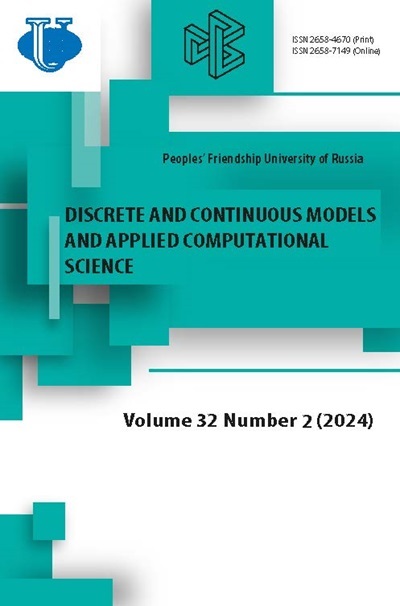О задаче многих тел с близкодействием
- Авторы: Гамбарян М.М.1, Малых М.Д.1,2
-
Учреждения:
- Российский университет дружбы народов
- Лаборатория информационных технологий им. М.Г. Мещерякова Объединённый институт ядерных исследований
- Выпуск: Том 30, № 1 (2022)
- Страницы: 52-61
- Раздел: Статьи
- URL: https://journals.rudn.ru/miph/article/view/30326
- DOI: https://doi.org/10.22363/2658-4670-2022-30-1-52-61
Цитировать
Полный текст
Аннотация
В статье рассматривается классическая задача о взаимодействии заряженных частиц в рамках представления о близкодействии. Обсуждаются трудности математического описания близкодействия, для чего необходимо объединение двух моделей - нелинейной динамической системы, описывающей движение частиц в поле, и краевой задачи для гиперболического уравнения или уравнений Максвелла, описывающих поле. Уделено внимание процедуре осреднения, то есть перехода от положений частиц и их скоростей к плотностям заряда и тока. Показано, что задача содержит несколько параметров, при стремлении которых к нулю в строго определённом порядке рассматриваемая модель переходит в классическую задачу многих тел. По методу Галёркина эта задача сведена к динамической системе, в которой к уравнениям, описывающим динамику частиц, добавляются уравнения, описывающие колебания поля в ящике. Эта задача представляет собой упрощение, отличное от того, которое ведёт к классической механике. Её предлагается рассматривать как простейшую математическую модель, описывающую задачу многих тел с близкодействием. Эта модель состоит из уравнений движения частиц, к которым добавлены уравнения, описывающие собственные колебания поля в ящике. Представлены результаты первых компьютерных экспериментов с этой моделью близкодействия. Показано, что модель богата законами сохранения.
Ключевые слова
Об авторах
М. М. Гамбарян
Российский университет дружбы народов
Автор, ответственный за переписку.
Email: gamb.mg@gmail.com
ORCID iD: 0000-0002-4650-4648
PhD student of Department of Applied Probability and Informatics
ул. Миклухо-Маклая, д. 6, Москва, 117198, РоссияМ. Д. Малых
Российский университет дружбы народов; Лаборатория информационных технологий им. М.Г. Мещерякова Объединённый институт ядерных исследований
Email: malykh-md@rudn.ru
ORCID iD: 0000-0001-6541-6603
Doctor of Physical and Mathematical Sciences, Assistant Professor of Department of Applied Probability and Informatics of Peoples’ Friendship University of Russia (RUDN University); Researcher in Meshcheryakov Laboratory of Information Technologies, Joint Institute for Nuclear Research
ул. Миклухо-Маклая, д. 6, Москва, 117198, Россия; ул. Жолио-Кюри, д. 6, Дубна, Московская область, 141980, РоссияСписок литературы
- C. K. Birdsall and L. A. Bruce, Plasma physics via computer simulation. Bristol, Philadelphia and New York: Adam Hilger, 1991.
- R. W. Hockney and J. W. Eastwood, Computer simulation using particles. Bristol, Philadelphia and New York: Adam Hilger, 1988.
- V. P. Tarakanov, User’s manual for code KARAT. Springfield, VA: Berkley Research, 1999.
- E. Hairer, G. Wanner, and S. P. Nørsett, Solving Ordinary Differential Equations, 3rd ed. New York: Springer, 2008, vol. 1.
- G. Duvaut and J. L. Lions, Inequalities in Mechanics and Physics. Berlin: Springer-Verlag, 1976.
- H. Qin, S. Zhang, J. Xiao, J. Liu, and Y. Sun, “Why is Boris algorithm so good?” Physics of Plasmas, vol. 20, p. 084503, 2013. doi: 10.1063/1.4818428.
- A. G. Sveshnikov, A. N. Bogolyubov, and K. V. V., Lectures on Mathematical Physics [Lektsii po matematicheskoy fizike]. Moscow: MGU, 1993, in Russian.
- I. I. Vorovich, “On some direct methods in the nonlinear theory of oscillations of shallow shells [O nekotorykh pryamykh metodakh v nelineynoy teorii kolebaniy pologikh obolochek],” Izvestiya Akademii Nauk USSR, Seriya Matematicheskaya, vol. 21, no. 6, pp. 747-784, 1957, in Russian.
- P. G. Ciarlet, The finite element method for elliptic problems. NorthHolland, 1978.
- N. G. Afendikova, “The history of Galerkin’s method and its role in M.V. Keldysh’s work [Istoriya metoda Galerkina i yego rol’ v tvorchestve M.V.Keldysha],” Keldysh Institute preprints, no. 77, 2014, in Russian.
- G. Hellwig, Partial differential equations. An introduction. Leipzig: Teubner, 1960.
- G. Hellwig, Differential operators of Mathematical Physics. Reading, MA: Addison-Wesley, 1967.
- A. N. Tikhonov, “Systems of differential equations containing small parameters at derivatives [Sistemy differentsial’nykh uravneniy, soderzhashchiye malyye parametry pri proizvodnykh],” Mat. Sb., vol. 31, no. 3, pp. 575-586, 1952, in Russian.
- A. B. Vassilieva and V. F. Butuzov, Asymptotic methods in singular perturbation theory [Asimptoticheskiye metody v teorii singulyarnykh vozmushcheniy]. Moscow: Vysshaya shkola, 1990, in Russian.
















